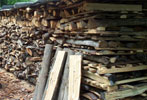Sign up for our newsletter for an instant promotion code and monthly specials
Massachusetts Bay Trading Co.
Artist Profiles
Keith Dufresne: Maple Syrup
The Massachusetts settlers learned sugaring from the Indians, who collected sap in hollowed-out logs and steamed away the water by dropping in hot stones. Today, the commonwealth produces about 50,000 gallons of maple syrup each year, almost all of it sold within state. Depending on the sweetness of the sap, it can take anywhere from 25-75 gallons of raw sap to make a gallon of finished syrup. Each tap into a tree will yield about 10 gallons of slightly sweet sap over a period of the 4-5 week sugaring season. This 10 gallons of sap, when boiled down, will yield approximately one quart of finished maple syrup.
Keith Dufresne's Sugar House has been making maple syrup for four generations, starting in Canada with his great-grandfather. The Dufresne operation has expanded to include taps in almost 7,000 maple trees. During the season, between 40 and 60 cords of wood are burned to boil the sap into syrup. Since one person can handle about two cords of wood per day, you can get an idea of how labor intensive maple syrup can be.

Keith's grandfather and father made syrup in Hawley, Ma until his father went off to war in 1941. In 1982, Keith purchased land in Williamsburg, MA. They set 300 sap buckets, but soon realized there was a better way and switched to tubing. With 550 taps, they could make 110 gallons of syrup. They are now up to 1,000 gallons and are switching from flexible to rigid tubing which can safely stay in the woods year round. Each tap still has to be handled three times per season. It starts when the new tap hole is drilled and the tap inserted into the tree. Then at cleaning time, each spout is removed and water is run through it. Finally, each spout and drop line has to be drained and plugged up until next season. Between forest upkeep, collecting wood to burn, maintaining the tubing system, repairing animal damage and then actually making the maple syrup, "sugaring" is quite a full time, year-round job.


